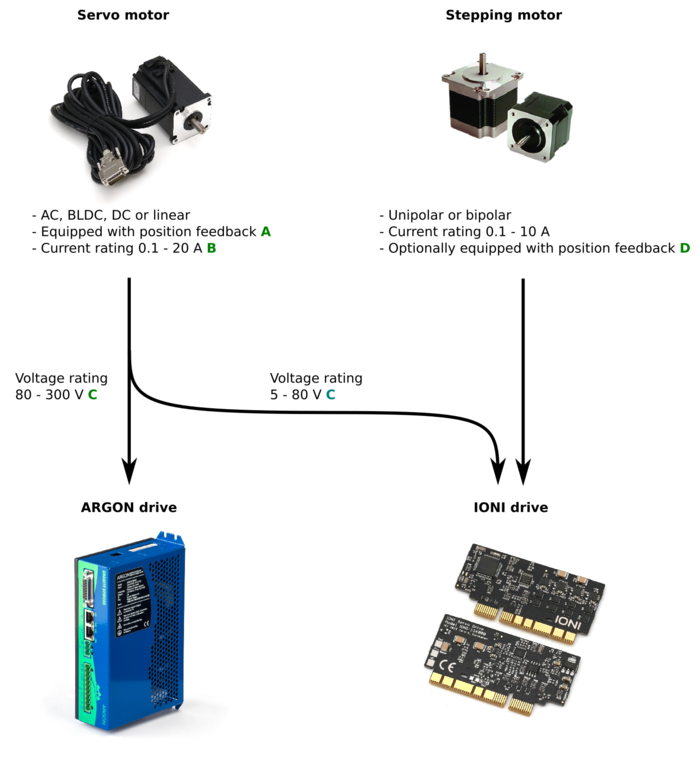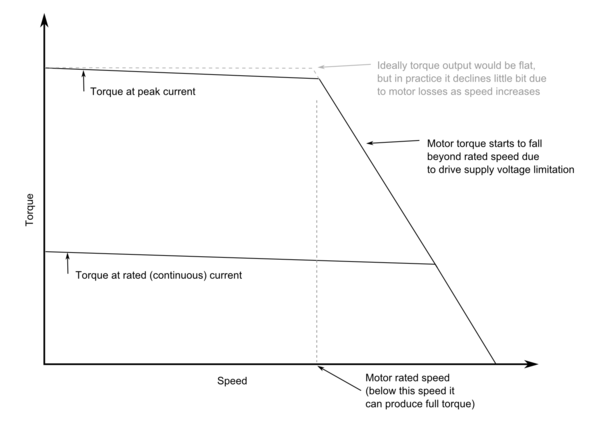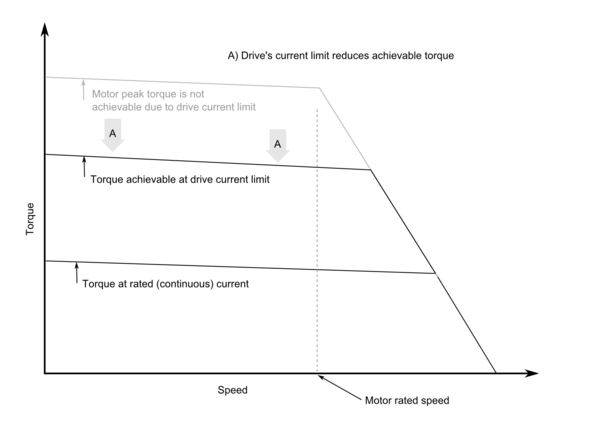Difference between revisions of "Motor compatibility guide"
| [checked revision] | [checked revision] |
(→Note B (current rating)) |
(→Note B (current rating)) |
||
| Line 35: | Line 35: | ||
{{tip|In many practical machines, maximum torque is not required which makes even undersized drive suitable. Drive or motor will not have any reliability issues by that mismatch.}} | {{tip|In many practical machines, maximum torque is not required which makes even undersized drive suitable. Drive or motor will not have any reliability issues by that mismatch.}} | ||
| − | {{info|Most AC motors specify currents in RMS value while Granite Devices drives specify it in [[peak value of sine]] value. To convert RMS current to peak-of-sine, multiply it by 1.41. I.e. if a three-phase AC servo motor peak current rating is 10A, one can set value of 14.1A as {{param|MMC}}.}} | + | {{info|Most AC motors specify currents in RMS value while Granite Devices drives specify it in [[peak value of sine]] value. To convert RMS current to peak-of-sine, multiply it by 1.41. I.e. if a three-phase AC servo motor peak current rating is 10A, one can set value of 14.1A as {{param|MMC}}. However, most BLDC motors (which are quite similar to AC motors) specify current as peak-of-sine value.}} |
==Note C (voltage rating)== | ==Note C (voltage rating)== | ||
Revision as of 15:27, 28 January 2016
This page guides through matching the Granite Devices drive and various kinds of servo and stepping motors.
Contents
Overview
Note A (position feedback device)
Servo motor requires a position feedback device to operate with servo drive. It is recommended to have a position sensor that has resolution of at least 1000 increments (a.k.a. counts) per revolution. The higher the resolution, the better servo stiffness can be achieved.
Feedback device type must be one of the supported types. Following types are supported by different drive models:
- ARGON
- Incremental quadrature encoder
- Resolver (with separately available Argon resolver adapter)
- More than 99% of encoders are directly compatible, for technical details of compatible types see ARGON motor compatibility page.
- IONI
- Incremental quadrature encoder
- SinCos encoder
- More than 99% of encoders are directly compatible, for technical details of compatible types see IONI motor compatibility page.
About Hall sensors
Many AC/BLDC motors come also with Hall sensors. Hall sensors are supported by ARGON & IONI drives but these are not required for operation and can be left unconnected. Connecting & enabling Hall sensor can be used to speed up motor initialization at power-on. For more info, see Phasing a.k.a. phase search.
Unsupported feedback devices
Feedback devices that are not listed as supported, can be assumed to be unsupported and unsuitable. Examples of such types are:
- Tachogenerator/tachometer
- Serial data encoders (BiSS, SSI, EnDat etc)
In case of unsupported type, motor can be usually made compatibly by installing a compatible encoder in it. Compatible encoders are widely available in may sizes and fit most motors in the market. See list of compatible feedback devices.
Note B (current rating)
Current is the component to produce torque on motor. Motor torque is directly proportional to torque generated with equation T=I*K where T is torque, I is current and K is the torque constant of motor (motor specific value, often defined in data sheet).
If drive is unable to drive (or is set deliberately to limit current) below motor ratings, it will cause the obtainable peak torque to be reduced. The reduction is proportional to the current reduction. For example, if motor is rated for 30A and drive can supply 20A, then torque is reduced by ratio 20/30 thus maximum obtainable torque is 67% of motor maximum rating.
| In many practical machines, maximum torque is not required which makes even undersized drive suitable. Drive or motor will not have any reliability issues by that mismatch. |
| Most AC motors specify currents in RMS value while Granite Devices drives specify it in peak value of sine value. To convert RMS current to peak-of-sine, multiply it by 1.41. I.e. if a three-phase AC servo motor peak current rating is 10A, one can set value of 14.1A as Peak current limitMMC. However, most BLDC motors (which are quite similar to AC motors) specify current as peak-of-sine value. |
Note C (voltage rating)
Voltage rating of motor originates from the characteristics of motor winding (voltage loss of motor + generated voltage of motor). Motor voltage rating is specified so that motor is able to operate at it's rated speed range and produce maximum torque whenever necessary.
If drive's supply voltage is less than motor's rated voltage, it eventually starts to reduce maximum obtainable speed of motor. This limit first appears at maximum torque, but if supply voltage is significantly less than motor voltage rating, motor will not be able to run at it's rated speed. Voltage and speed are directly proportional. For example if motor voltage rating is 100V, and drive supply voltage is 50V, then top speed may be reduced as much as 50%. In practical cases, speed loss is less because motors usually have headroom for voltage variations so in reality 100V to 50V drop might cause motor to lose only 20-40% of rated speed.

Example of motor torque vs speed curves with drive that has lower supply voltage than motor specification
| In many practical machines, maximum speed is not required which makes even undersized voltage suitable. Drive or motor will not have any reliability issues by that mismatch. |
Note A and B combined (current & voltage rating)
If motor has higher voltage AND current rating of drive, it will mean reduction of maximum speed and torque.

Example of motor torque vs speed curves with drive that has lower supply voltage AND lower output current than motor specification
| Drive or motor will not have any reliability issues by that mismatch. |
Note D (stepping motor feedback)
Stepping are used traditionally without any feedback devices (in open loop mode) or with feedback device (position sensor) to run in closed loop mode. For explanation of different possible modes, see Using stepping motor with IONI.


